
The Northrop Grumman E-2 Hawkeye is an American all-weather, carrier-capable tactical airborne early warning (AEW) aircraft. This twin-turboprop aircraft was designed and developed during the late 1950s and early 1960s by the Grumman Aircraft Company for the United States Navy as a replacement for the earlier, piston-engined E-1 Tracer, which was rapidly becoming obsolete. The aircraft's performance has been upgraded with the E-2B and E-2C versions, where most of the changes were made to the radar and radio communications due to advances in electronic integrated circuits and other electronics. The fourth major version of the Hawkeye is the E-2D, which first flew in 2007. The E-2 was the first aircraft designed specifically for its role, as opposed to a modification of an existing airframe, such as the Boeing E-3 Sentry. Variants of the Hawkeye have been in continuous production since 1960, giving it the longest production run of any carrier-based aircraft.

Carrier Airborne Early Warning Squadron 121 (VAW-121), also known as the "Bluetails", is an Airborne Early Warning (AEW) and Command and control (C2) squadron of the United States Navy, operating the E-2D Hawkeye. Established in 1967, the squadron is based at NAS Norfolk. It is currently assigned to Carrier Air Wing 7 and deploys aboard the aircraft carrier USS Abraham Lincoln.

Fighter Squadron Composite 12 (VFC-12), also known as the "Fighting Omars", is a United States Navy Reserve fighter squadron based at NAS Oceana. It provides adversary training to East Coast Navy air wings. VFC-12 reports to Tactical Support Wing, a component of the Naval Air Force Reserve. The "Fighting Omars" are manned by selected reservists, full-time reservists (FTS) and active duty personnel.

A carrier air wing is an operational naval aviation organization composed of several aircraft squadrons and detachments of various types of fixed-wing and rotary-wing aircraft. Organized, equipped and trained to conduct modern US Navy carrier air operations while embarked aboard aircraft carriers, the various squadrons in an air wing have different but complementary missions, and provide most of the striking power and electronic warfare capabilities of a carrier battle group (CVBG). While the CVBG term is still used by other nations, the CVBG in US parlance is now known as a carrier strike group (CSG).
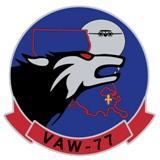
Carrier Airborne Early Warning Squadron 77 (VAW-77) "Nightwolves" was an aviation unit of the United States Navy Reserve based at Naval Air Station Joint Reserve Base New Orleans from 1995 to 2013. It comprised the U.S. Navy's only fully dedicated counter-narcotics squadron.

The Tactical Support Wing (TSW) is one of three reserve aircraft wings of the United States Navy. The wing reports to the Commander, Naval Air Force Reserve. It is headquartered at Naval Air Station Joint Reserve Base Fort Worth, Texas along with the reserve's Fleet Logistics Support Wing (FLSW). The third reserve wing is the Maritime Support Wing (MSW) which is headquartered at Naval Air Station North Island, California. The wing's primary mission is operational and training support for active forces. It is composed of five flying squadrons.
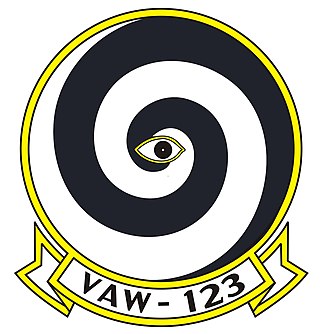
Airborne Command and Control Squadron 123 (VAW-123) is based at Naval Station Norfolk, flying the E-2C Hawkeye. They are attached to Carrier Air Wing Three (CVW-3) while deployed aboard USS Dwight D. Eisenhower. The squadron nickname is the Screwtops.

Airborne Command & Control Squadron 116 (VAW-116) is a US Navy Command and Control Squadron that deploys aboard USS Nimitz as part of Carrier Air Wing Seventeen, flying the E-2C Hawkeye 2000 aircraft. VAW-116 is stationed at Naval Base Ventura County under the cognizance of Commander, Airborne Command Control and Logistics Wing (COMACCLOGWING). The current commanding officer is Commander Phillip J. Sheridan.

Airborne Command & Control Squadron 117 (VAW-117) is an airborne early warning (AEW) squadron. Nicknamed "The Wallbangers", it flies the E-2D Hawkeye, the USN's only carrier-based command and control platform. The squadron is based in NAS Point Mugu and deploys as part of Carrier Air Wing 9 (CVW-9) on board USS Abraham Lincoln.

Airborne Command & Control Squadron 113 (VAW-113), known as "Black Eagles", was established on 20 April 1967 flying the E-2A Hawkeye.

Carrier Airborne Early Warning Squadron 115 (VAW-115), also known as the "Liberty Bells", is a United States Navy airborne early warning and control squadron that flies the E-2C Hawkeye.
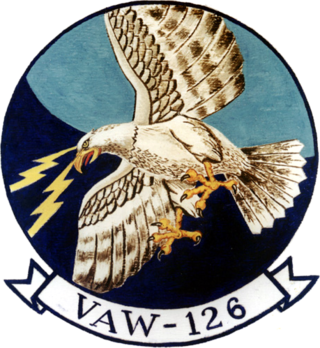
Carrier Airborne Early Warning Squadron 126 (VAW-126), nicknamed the "Seahawks", is a carrier airborne early warning squadron of the United States Navy. The squadron is based at NS Norfolk, equipped with five E-2D Hawkeye aircraft.

Carrier Airborne Early Warning Squadron 112 (VAW-112) is an inactive United States Navy squadron. It was nicknamed the "Golden Hawks". VAW-112 flew the E-2C Hawkeye out of NAS Point Mugu and last deployed as part of Carrier Air Wing 9 (CVW-9) on board USS John C. Stennis.

Airborne Command & Control Squadron 120 (VAW-120) is a United States Navy Fleet Replacement Squadron responsible for training crews on the E-2 Hawkeye and the C-2A(R) Greyhound.

Airborne Command & Control Squadron 124 (VAW-124) "Bear Aces" is a United States Navy airborne early warning and control squadron based at Naval Air Station Norfolk, Norfolk, Virginia (USA). It flies the Northrop Grumman E-2D Hawkeye and is currently attached to Carrier Air Wing 8 (CVW-8).
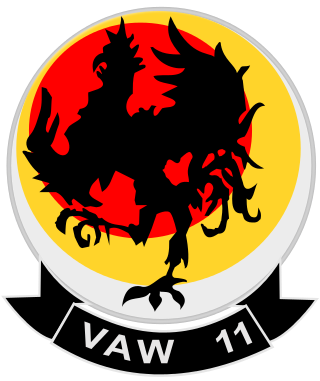
Carrier Airborne Early Warning Squadron 11 (VAW-11), nicknamed the "Early Elevens", was an airborne early warning squadron, whose mission was to provide services to fleet forces and shore warning networks, under all weather conditions. The squadron was also responsible for combat air patrol and Anti-submarine warfare (ASW) missions. It was based at NAS North Island in San Diego, California, but had detachments serving aboard 13 attack carriers and antisubmarine carriers in the Pacific Fleet.
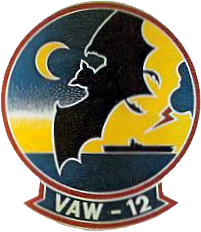
Carrier Airborne Early Warning Squadron 12 (VAW-12), nicknamed the "Bats", was a U.S. Navy Carrier Airborne Early Warning Squadron. The squadron was disestablished on 1 April 1967.

Carrier Airborne Early Warning Squadron 110 (VAW-110), nicknamed the "Firebirds", was an aviation unit of the United States Navy based at NAS Miramar.The Firebirds were a training squadron for the E-2 Hawkeyes. It was disestablished in September 1994.





















